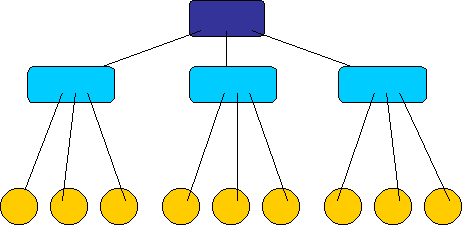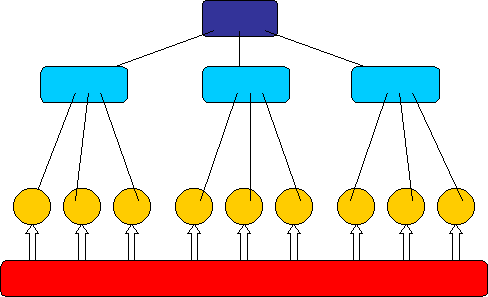 The Write Place: Guides for Writing and Grammar .............................Home
The Write Place: Guides for Writing and Grammar .............................HomeDevelopment
The Guides The Nature of an Essay and Organization discuss the basic characteristics of an "essay" and how to structure the BODY of an essay. In these guides, I talked about "dividing up the proof" and following the simple rule of only putting one main supporting idea or reason in each paragraph. In this Guide, we will focus on development or support.
I mentioned before that your job as an essay writer is "to make a point and support it."
One big question you may have is "HOW MUCH SUPPORT DO I NEED?"
The answer, of course, is "ENOUGH TO BE CONVINCING."But, how much support do you need to be convincing?
A general rule to follow is to
INCLUDE THREE SUPPORTS FOR ANY ASSERTION
A wise writing teacher I once had said, "it takes three trees to make a row." You may have four or five supports, or you may have two exceptional ones, but try always to bring in three at least. It seems to take three supports to cross the threshold to being convincing.
Your main supporting points (called PRIMARY SUPPORTS) will most likely be REASONS when writing an Argument/Persuasion Essay. Different kinds of essays will call on you to use different kinds of PRIMARY SUPPORTS. For a Process/Analysis Essay, each PRIMARY SUPPORT would be a step or stage in the process being written about. For a Cause/Effect Essay, each PRIMARY SUPPORT would be a key cause or important effect.
 |
One comparison to illustrate PRIMARY SUPPORTS is to think of a chair or stool. If your THESIS is like the seat of the chair, then your PRIMARY SUPPORTS are the legs. These PRIMARY SUPPORTS are the main props holding up your thesis. |
Remember, in the BODY of your essay, you will put only one PRIMARY SUPPORT per body paragraph. In fact, your PRIMARY SUPPORTS define your BODY paragraphs. Each paragraph in the BODY of your essay should contain and support one PRIMARY SUPPORT. If you have paragraphs in your essay that are not completely supporting one PRIMARY SUPPORT, they you should examine your structure of support and your paragraphing.
Each of these PRIMARY SUPPORTS will need support also (called SECONDARY SUPPORTS). Here is a list of the type of material you might include as secondary support for your PRIMARY SUPPORT:
1) Concrete detail: All your support, in a sense, will be making things detailed, but you should seek to provide detail for any general, vague statements.
2) Specific examples: These may come from your personal experience, your general knowledge, or from research.
3) Incidents or anecdotes: You might use a brief story or incident to illustrate a more general point. Sometimes I call these, "example stories."
4) Facts or Statistics: These might require you to do some research.
THE LEVELS OF GENERALITY
To understand how to set up your support, I want to introduce you to the
idea of "levels of generality." The job of "making a point
and supporting it" means you will present ideas that move from general
to specific. The position (or thesis) is the general point, while the
primary supports are the larger class of specific supports for the position.
Each of these PRIMARY SUPPORTS will need more specific support. This way
of thinking (logic) is sometimes called "downshifting." From
your general point, you "downshift" to more specific support.
Let's follow this "downshifting"
for an essay:
Imagine that you have a point (or position/thesis). How much support do
you need? Three, of course.
|
POINT
|
|
|
Level
of PRIMARY SUPPORT
|
But PRIMARY SUPPORTS, themselves are general in nature and need supporting. How much support do these PRIMARY SUPPORTS need?--three as well.
|
POINT
|
|
|
Level
of PRIMARY SUPPORT
|
|
|
Level
of Secondary Support
|
Finally, even the secondary supports need detail. How much detail? Three would be nice, but the amount of detail you include will vary. Perhaps you will have more, perhaps less.
|
POINT
|
|
|
Level
of PRIMARY SUPPORT
|
|
|
Level
of SECONDARY SUPPORT
|
|
|
Level
of DETAILED SUPPORT
|
EXERCISE: IDENTIFYING SUPPORT--SEEING
THE LEVELS OF GENERALITY AT WORK IN AN ESSAY
Look at the model essay below. I want you to identify both the PRIMARY
SUPPORTS (the main supports or reasons that define the paragraphs) and
the SECONDARY SUPPORTS (the details, examples, or other evidence that
support the primary support), and fill in the OUTLINE on the following
page. Don't worry about filling in the details in support of the Secondary
Supports. I have done the first body paragraph to help you get started.
Do body paragraphs two and three and check your answers on the link following
the outline.
HINT: In the BODY of the essay, I suggest going sentence by sentence.
Ask this question of each successive sentence to figure out what level
of generality it is on.
Is this sentence more general? more specific? or the same level of generality
as the sentence before it? Also, notice the transitions or signal words
that are highlighted in the first body paragraph. They signal to the reader
when the writer is moving up or down in the levels of generality.
Model Essay
"Showing next Saturday on CBS, 'Blood for Money,' a true life story of a crazed man who takes two small children hostage." It seems every time you turn on the TV there are guns going off, car wheels screeching and fists flying. For many years, there have been complaints about the excessive violence shown on TV. Should we get the government to step in and regulate this violence? Despite my own belief in the free market and freedom of speech, I think TV violence is out of hand, and the government should do something to regulate it.
First of all, the government should crack down on TV violence because the violence is too excessive. Although we live in a violent world, and violence has been a part of theatre and entertainment for years, the huge amount of violence on TV presents a distorted view of reality. Personally, I have never seen a real murder or even heard a gun fired other than when I was hunting, but I can turn on the TV and in one night see five to ten of these at least. In addition to the excessive amount of violence, the graphic way the shows portray the violence is also inappropriate. One example of this graphic violence comes from the first Indiana Jones movie where the German gestapo officer's face exploded as the camera focused on it (although movies like this were in theatres at first, they now are a regulars on cable TV). This type of graphic depiction of mutilation is not needed. The excessive violence is also blatantly manipulative. Death, fear of death, and violence are always going to attract our attention--it is the lowest common denominator. By putting violence on TV, networks use the worst means to draw viewers to their shows.
Secondly, the government should limit TV violence because the government is the best institution to do the regulating. The government can make and enforce regulations with the weight of law behind it. For instance, a network that shows too graphic a killing with blood spattered everywhere might be fined one hundred thousand dollars. This might make them think twice about the violence they show. In addition, the government is best equipped to do the job because they already regulate TV. The FCC (Federal Communications Commission) already limits the amount of obscenity and nudity that can be shown. It would be easy for them to add on violence to their list. Lastly, the government is needed because the TV indrustry is unable to regulate themselves. Some believe that the current warning messages are enough, but excessive violence is still being shown. The ax-murderers, gangsters, rapists and serial killers still fill the TV screen, and many times parents aren't there to prevent their children from watching them. The government is needed to get this trash off the screen.
Finally, and most importantly,
we must get the government to limit TV violence for the sake of our society,
especially our children. Children are influenced by what they see on TV,
and all the violence on TV is making them more violent. For instance,
I've seen kids just after they have watched the teenage mutant ninja turtles,
and they kick and chop at each other as they try to fight like the ninja
turtles. Some kids even set fire to a house killing one person as they
imitated what they had seen on Beavis and Butthead. Too much TV violence
also teaches kids that violence is a way to solve conflict rather than
other more positive ways like communication and compromise. Little Johnny
learns from TV that shooting or hitting someone is the quickest and easiest
way to get what he wants. Most of all, we need do something to stop the
spread of the teenage epidemic of violence. On the evening news we hear
about gangs that drive by and shoot each other, students who pull guns
on teachers, and young men who rape and kill young girls. Seeing this
same type of violence on TV must inspire and even confirm their behavior.
For the sake of our youth and our future, we must put a stop to the abusive
violence on TV.
In conclusion, violence is toxic and, just like cigarettes were banned
from TV years ago, we should ban excessive violence from television. The
government has the right in the interest of protecting public safety to
step in and stop the bloodshed on TV--perhaps that will help stop some
of the bloodshed off the TV.
OUTLINING:REVEALING THE LOGICAL SKELETON
Introduction--
Position/Thesis: Violence is out of hand, and the govt. should do something
to regulate it (TV violence).
P#2 1st Primary Support: I support regulation because the violence is
excessive
Secondary Supports
1:huge amount presents a distorted view of reality and is excessive
2:excessiveness also shown in the graphic portrayal of violence, excessively
inappropriate
3:it is also excessive in its manipulative
P#3 2nd Primary Support: _________________________________________________
_____________________________________________________________________________
Secondary Supports
1:
2:
3:
P#4 3rd Primary Support: __________________________________________________
______________________________________________________________________________
Secondary Supports
1:
2:
3:
Conclusion:
Note: This is an "idealized model." Your essay may have more
or less of these supports.
THE IMPORTANCE OF DETAILS:
I cannot stress enough how important it is for you to get details into your essay. While your reasons may be convincing alone, they only work on a general level; details do the real proving. These details are the evidence (the murder weapon, the bloody glove, the fingerprint) which you present to your jury, and the jury (your readers) isn't going to be convinced by what you TELL them, but by what you SHOW them. This showing comes in the form of concrete details.
For example, in the first body paragraph, the excessiveness of TV violence is shown through the details of the five to ten gun shots and murders a night, the example of graphic violence from Indiana Jones, and the fact that death and violence will always attract our attention and thus to use it is manipulative. Details. Details. Details. Writing in a detailed way calls on you to include material which you might take for granted or you think is obvious and implied in what you have written. Unfortunately, the reader can't read your mind and has only what is written on the page to go on. So, alas, you have to tell the reader and show him or her fully what you are trying to say.
Looking at following
page, you can see this same model essay "anatomized," with marginal
comments identifying key parts of the essay and its structure.

Free Web Counter
(Since 1/12/16)

This work is licensed under a Creative Commons Attribution-NonCommercial 4.0 International License | Contact Lirvin | Lirvin Home Page | Write Place Home


